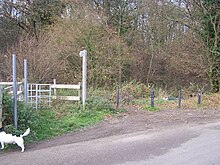| Site of Special Scientific Interest | |
 | |
| Location | Kent |
|---|---|
| Grid reference | TQ 702 703[1] |
| Interest | Biological |
| Area | 33.0 hectares (82 acres)[1] |
| Notification | 1984[1] |
| Location map | Magic Map |
Great Crabbles Wood is a 33-hectare (82-acre) biological Site of Special Scientific Interest north-west of Rochester in Kent.[1][2]
Most of the wood is mixed coppice, with sweet chestnut dominant and oak standards. There are scarce flora such as lady and man and bird's nest orchids, white helleborine and wild liquorice.[3]
The wood is crossed by footpaths.
References
[edit]- ^ a b c d "Designated Sites View: Great Crabbles Wood". Sites of Special Scientific Interest. Natural England. Archived from the original on 7 February 2018. Retrieved 6 February 2018.
- ^ "Map of Great Crabbles Wood". Sites of Special Scientific Interest. Natural England. Retrieved 6 February 2018.
- ^ "Great Crabbles Wood citation" (PDF). Sites of Special Scientific Interest. Natural England. Retrieved 6 February 2018.
Well, that’s interesting to know that Psilotum nudum are known as whisk ferns. Psilotum nudum is the commoner species of the two. While the P. flaccidum is a rare species and is found in the tropical islands. Both the species are usually epiphytic in habit and grow upon tree ferns. These species may also be terrestrial and grow in humus or in the crevices of the rocks.
View the detailed Guide of Psilotum nudum: Detailed Study Of Psilotum Nudum (Whisk Fern), Classification, Anatomy, Reproduction